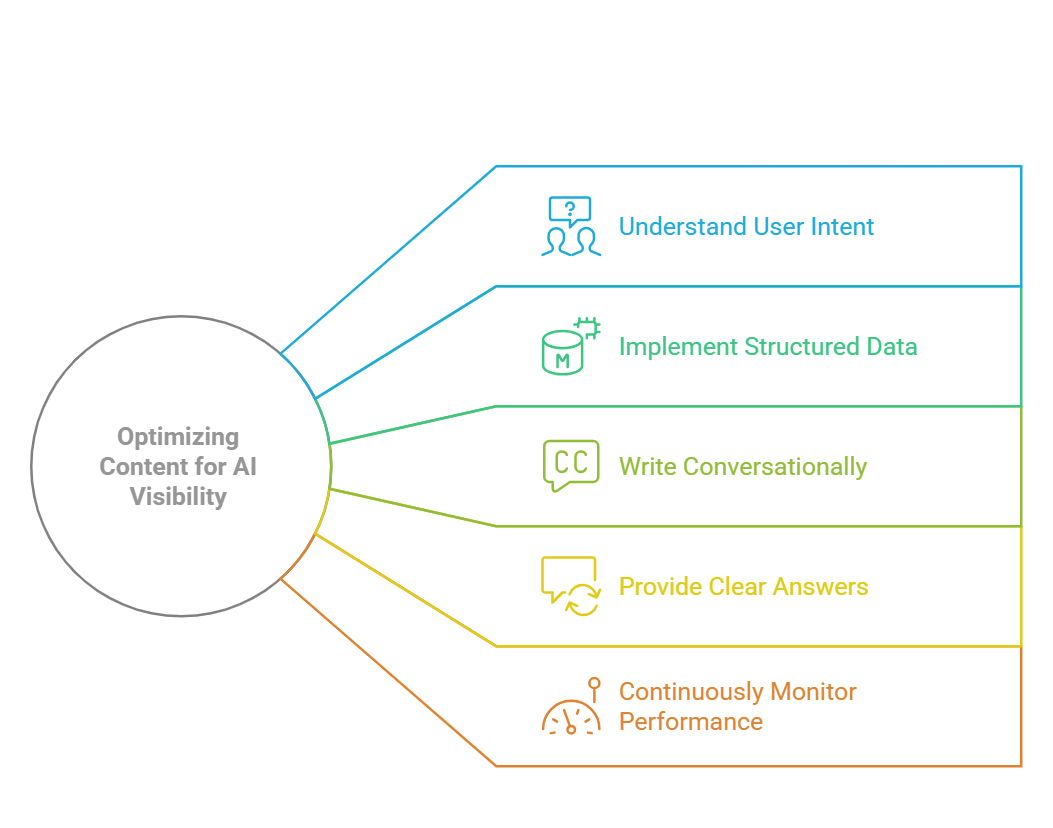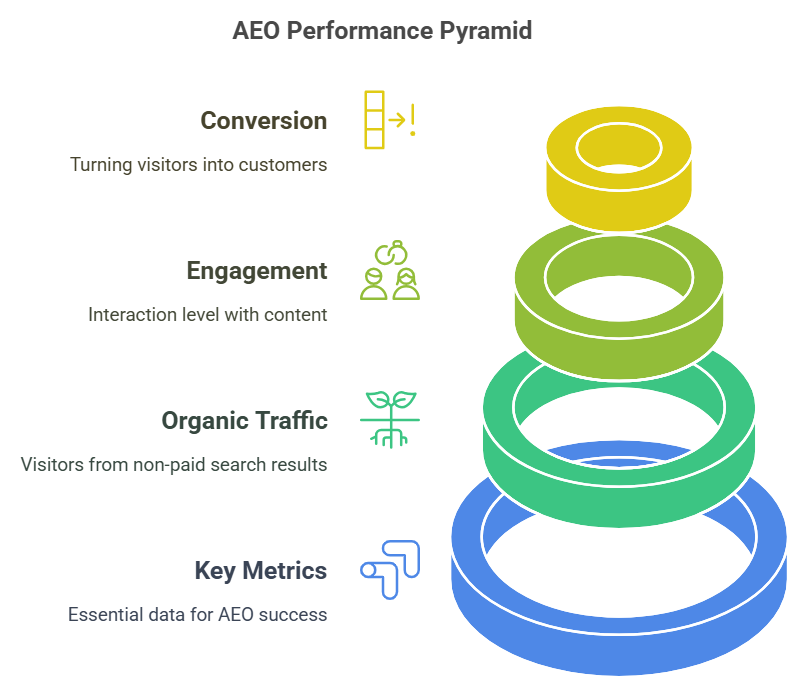Key Takeaways
- AEO focuses on optimizing content for AI-powered answer engines, while traditional SEO targets ranking positions in search results
- By 2026, traditional search volume is projected to drop 25% as users shift to AI chatbots and virtual assistants
- Structured data and schema markup are essential for making your content machine-readable for AI systems
- Geographic specificity in your content helps solve the problem of ranking in unintended regions (like Pakistan instead of San Francisco)
- AEO offers faster ROI than traditional SEO, with first citations possible within 3-6 weeks of proper implementation
- Different AI models (ChatGPT, Google SGE, Perplexity) have unique content preferences that require specific optimization approaches
- Measuring AEO success requires tracking AI citations, referral traffic from answer engines, and conversion rates from these sources
You used to write for Google. But now, you’re writing for everyone: search engines, voice assistants, and AI tools. They all have one thing in common: they want clear, direct answers, not long, boring passages.
In fact, Gartner predicts that by 2026, traditional search volume will drop by 25%, as more people turn to AI chatbots and virtual assistants instead of Google.
That’s where Answer Engine Optimization comes in. It ensures your content shows up when someone asks the exact question you set out to solve. It helps you earn visibility by being useful.
In this guide, we will understand what AEO means, how it compares to traditional SEO, and what steps you need to take to keep your content visible.
What is Answer Engine Optimization?
Answer Engine Optimization, or AEO, is the practice of structuring your content to provide direct, clear answers to user questions. It increases the chances of your content appearing in featured snippets, voice search results, AI-generated summaries, and other answer-first formats across platforms like:
- Google's Search Generative Experience (SGE)
- ChatGPT with browsing capabilities
- Perplexity AI
- Bing Copilot
- Voice assistants (Siri, Alexa, Google Assistant)
- Claude AI and other emerging AI search tools
The evolution of AEO has accelerated dramatically with the rise of generative AI. While traditional featured snippets have existed for years, today's AI engines go beyond simple extraction—they synthesize information from multiple sources, prioritize recency and authority, and present conversational responses that directly answer user questions.
Today, users ask detailed, conversational questions and expect immediate clarity. AEO ensures your content meets that expectation in a format that search engines and AI tools can easily interpret.
You’ll often see AEO-driven content in:
- Featured snippets
- “People Also Ask” boxes
- Voice search results
- AI-generated results on tools like ChatGPT or Perplexity
AEO and SEO are closely related, but understanding their key differences will help you leverage both effectively.
How Does AEO Differ from Traditional SEO?

Traditional SEO puts you in the search results. Answer Engine Optimization puts you directly into the conversation.
The distinction matters because visibility alone isn’t enough anymore. Users expect immediate answers, not just links to pages. AEO is how you become that answer.
The technical implementation of AEO also differs significantly from traditional SEO. While both require quality content, AEO places greater emphasis on:
- Structured data implementation: Schema markup like FAQPage, HowTo, and Article help AI systems understand your content's purpose and structure
- Entity optimization: Clearly defining entities (people, places, products) and their relationships helps AI systems build accurate knowledge graphs
- Voice search readiness: Conversational, question-based content that matches natural speech patterns
- AI-friendly formatting: Short paragraphs, bulleted lists, and direct answers that AI can easily extract
Consider these query examples that trigger different optimization approaches:
- Traditional SEO query: "contract management software pricing"
- AEO query: "What's the average cost of contract management software for a 50-person company?"
The first query might lead to a traditional SERP with rankings, while the second is likely to trigger an AI-generated answer that synthesizes information from multiple sources.
Despite these differences, AEO and SEO work together rather than competing. Your traditional SEO efforts build the authority and visibility that help AI systems discover your content, while your AEO efforts ensure that when they do find it, they can easily extract and cite the information they need.
AEO vs GEO
While Answer Engine Optimization (AEO) and Generative Engine Optimization (GEO) both address AI-driven content discovery, they target different aspects of the AI ecosystem.
AEO focuses on the immediate citation of your content in response to specific queries. When someone asks, "How do I implement hreflang tags for a multi-regional SaaS website?", AEO ensures your content is structured to be the clearest, most authoritative answer.
GEO, meanwhile, takes a longer view. It aims to influence how AI systems understand concepts related to your business. For example, a SaaS marketing agency might use GEO to ensure AI systems accurately represent their methodology when generating content about marketing strategies.
You can also check out our co-founder Manoj Palanikumar’s interview, where he breaks down AI Search myths here.
Now that the difference is clear, the next logical question is—should you care? Well, yes.
Should Businesses Look into AEO Now?
Short answer: Yes. Long answer: Again, yes.
Search habits have dramatically evolved, not just because of voice search, but due to the rapid rise of AI-driven search experiences. People are no longer limited to keywords; they're asking detailed, conversational questions directly to AI platforms like ChatGPT, Bing Chat, and Google's AI-enhanced search.
Users expect immediate, accurate answers without needing to click through multiple links.
In fact, more than half of searches now conclude without a single click because AI-generated snippets and answers deliver exactly what users need upfront.
For example, if someone asks an AI tool, “What’s the difference between SEO and SEM?”, your content should be structured clearly and concisely for AI to recognize, summarize, and cite your answer instantly.
That's the new standard—optimizing content for AI visibility.
The data supports this urgency. According to Search Engine Land, more than half of searches now conclude without a single click because AI-generated snippets and answers deliver exactly what users need upfront. For businesses, this represents both a threat and an opportunity.
The shift is particularly pronounced among younger users. Gen Z is way more likely than Baby Boomers to use AI search tools as their primary information source, according to a 2024 Pew Research study. This generational preference signals where search behavior is headed—toward conversational, direct answers rather than traditional link-based results.
For example, if someone asks an AI tool, "What's the difference between SEO and SEM?", your content should be structured clearly and concisely for AI to recognize, summarize, and cite your answer instantly.
So, how do you actually show up in AI summaries, voice searches, and snippets? It starts with how you structure your content and what questions you build it around.
TripleDart’s Playbook to Optimize for AI Search Visibility

We’ve helped several brands such with their AEO challenges. For instance, we helped Meegle grow AI citations by 134% by aligning their content with AI search requirements
Creating content for AI visibility is more than good writing. You need a strategy that aligns with the way AI platforms actually serve answers.
Here’s how we approach this at TripleDart:
1. Start with real user intent (because keywords don't cut it anymore)
People don't search keywords. They ask questions. Specific, sometimes bizarrely detailed questions.
And about 1 in 10 keywords has an AI overview of some kind. That means Google's already answering user questions directly on the SERP. So, you either show up clearly, or you're lost in the noise.

To find what an audience truly wants to know, turn to:
- Google's "People Also Ask" boxes
- AnswerThePublic (to uncover deeper audience curiosities)
- Reddit and Quora conversations
Not every question is worth building around. Look for those with clear search volume, commercial or informational intent, and alignment with your product or service. Use tools like AlsoAsked to map follow-up queries, and validate your findings in Google Search Console to spot gaps your existing content isn’t covering.
The best-performing answer engine optimized content solves real problems in fewer words than your competitors.
2. Make structured data your best friend
Structured data or schema markup is your ticket to getting noticed by Google, Siri, and AI.
For instance, Rotten Tomatoes saw a 25% higher click-through rate for 100,000 unique pages enhanced with structured data compared to pages without structured data.
Specifically, mark up your content clearly and precisely as:
- FAQs
- How-to guides
- Product specs
- Service details
One of the biggest blockers to structured data adoption is developer dependency. If your CMS doesn’t support easy schema integration, use tools like Schema App or Merkle’s Schema Generator to generate the code.
Even Google’s Structured Data Markup Helper makes it simple. Here's how to use it:
- Visit Google's Structured Data Markup Helper
- Select your data type (e.g., articles, FAQs, products)
- Enter your page URL or paste HTML content directly
- Highlight text and tag it according to Google's instructions
- Generate the structured data code and embed it into your website
RAG framework implementation: Retrieval-Augmented Generation (RAG) is how modern AI systems find and incorporate external information. To optimize for RAG, ensure your content has:
- Clear entity relationships (Product → Features → Benefits)
- Consistent terminology (avoid synonyms for key concepts)
- Explicit answers to common questions (What, Why, How, When)
Case Study Example
In 6 months, we transformed Signeasy’s LLM presence—growing monthly sessions from 20 to 800 (a 3,650% increase), expanding their LLM page visibility from 3 to 55+ pages, and generating 98 qualified leads.
Check out how we helped Signeasy grow: Read Case Study
3. Talk (or write) like humans actually talk
Voice search is conversational. It’s like chatting over coffee—not reading a research paper. 62% of Americans regularly perform voice searches on devices like smartphones, smart speakers, laptop, in-car systems, etc.
So,
- Keep sentences short, punchy, and clear
- Drop jargon unless it's crucial
- Write exactly as you'd say it out loud
Instead of optimizing for a typed search keyword like, "seo tools," optimize for a question a user might ask Siri: "Hey Siri, what is the best SEO tool for our marketing department?"
4. Deliver quick, scannable, and direct answers
Nobody clicks hoping to wade through paragraphs. They want clarity immediately.
An EngineScout study confirms that featured snippets get about 35% of all clicks for that keyword or question. This is because they deliver answers in around 40-60 words, which is exactly the length that users prefer for direct queries.
So, get straight to the point:
- Lead with your key insight or takeaway
- Bullet your supporting points clearly
- Include summaries and FAQs
Bonus tip: Consider adding a TL;DR (Too long, Didn’t Read). This Reddit user tried it, and it boosted conversions by 33%.
5. Keep an eye on what's actually working
The search landscape is constantly changing. AI updates quickly. User habits shift.
You can’t optimize once and expect it to stick. At TripleDart, we regularly review the following to see what’s working.
- Organic traffic
- Bounce rates
- Time on page
- Click-through rates from search
Using Google Search Console, we see exactly what questions or keywords trigger your content. We then update what is not working by trying new formats and testing new ideas.
We use a simple feedback loop to refine AEO content:
- Trigger check: What queries are surfacing our page?
- Snippets audit: Are we being picked as the featured snippet?
- Behavior review: Are users bouncing or scrolling?
- Content refresh: What can be improved in 100 words or less?
This loop runs monthly for top-performing pages. Sometimes, a single rewritten sentence boosts visibility. The goal is to keep surfacing repeatedly, across formats.
Read how TripleDart increased Rezolve.ai’s organic traffic by 99% and leads by 136%
Implementing answer engine optimization is half the battle. Knowing if it’s working? That’s where performance tracking comes in.
6. Optimize for specific AI models
Different AI platforms may have distinct content preferences. Here is the common consensus on platform-wise preferences:
Google SGE:
- Prioritizes E-E-A-T signals (Experience, Expertise, Authoritativeness, Trustworthiness)
- Favors content with clear headings and schema markup
- Rewards recent content updates
Optimization tips:
- Implement comprehensive schema markup (especially FAQPage and HowTo)
- Create content that directly answers common questions in your niche
- Maintain strong traditional SEO signals (backlinks, site authority)
ChatGPT:
- Values comprehensive coverage of topics
- Cites sources with strong domain authority
- Prefers content with clear entity relationships
Optimization tips:
- Create definitive guides that cover topics thoroughly
- Include clear entity relationships and definitions
- Update content regularly to maintain recency signals
Perplexity AI:
- Heavily weights recency of information
- Favors direct answers to specific questions
- Often cites content with numerical data and statistics
Optimization tips:
- Include current data, statistics, and research findings
- Structure content with clear question-answer formats
- Update time-sensitive content frequently
Voice Assistants (Siri, Alexa, Google Assistant)
Voice assistants require special consideration due to their audio-only interface.
Key characteristics:
- Prefer concise, spoken-language answers
- Often pull from featured snippets and knowledge panels
- Need content that sounds natural when read aloud
Optimization tips:
- Write in conversational, natural language
- Keep answers brief (40-60 words for key questions)
- Structure content to directly answer who, what, when, where, why, and how questions
How to Monitor your AEO Performance

You would not launch a marketing campaign without tracking it. The same applies to answer engine optimization. Measuring results is how you refine your approach and keep improving.
Here is what to track and why it matters:
1. Organic traffic
This is your first signal.
Check if your AEO-focused pages are bringing in more visitors from search.
If traffic is flat or dropping, ask yourself:
- Are you targeting the right search queries?
- Are users landing on the right pages, the ones built to answer questions?
- Is your content showing up in featured snippets or AI responses?
- Have search trends changed recently?
Even small changes in user behavior can impact traffic. Staying on top of these patterns gives you the insight to respond quickly.
Cross-platform tracking: To get a complete picture, you need to monitor your visibility across multiple AI platforms:
- Google SGE: Use Search Console to track when your content appears in AI overviews
- ChatGPT: Monitor referral traffic from chat.openai.com and track brand mentions
- Perplexity: Check referrals from perplexity.ai and use their citation tracking features
- Bing Copilot: Monitor Bing Webmaster Tools for AI appearance signals
It's common to see traditional organic traffic decline while AI citations increase - so don’t be surprised if it happens!
2. Click-through rates (CTR)
Getting visibility is one thing. Getting clicks is another.
If your content appears in snippets or summaries but your CTR is low, it could mean:
- Maybe your answer is too vague
- Maybe it gives everything away up front, so users don’t need to click
- Or maybe your headline just isn’t clear and strong enough
Tweak your titles. Test your introductions. Give people a reason to click, not just scroll past. AI may surface your content, but users still make the final decision.
3. Engagement metrics
Once someone lands on your page, are they sticking around?
Look at:
- Time on page: Are users reading the full answer or leaving after five seconds?
- Bounce rate: Are they clicking into deeper parts of your site, or are they gone immediately?
- Scroll depth: Are they just skimming, or actually exploring your content?
These metrics help you see if your content is useful, easy to read, and well-structured.
Tools to track performance
You don't need a massive tech stack to track AEO. These specialized tools can help you monitor your performance across AI platforms:
Core Tracking Tools
- Google Analytics: For traffic, bounce rate, and time on page
- Google Search Console: For keyword data, CTR, and visibility insights
- AnswerThePublic or AlsoAsked: To find new questions people are searching
AI-Specific Tracking Tools
- Surfer AI Tracker: Monitors your content's appearance in AI-generated responses across platforms
- OmniSEO: Tracks featured snippets, knowledge panels, and AI overview appearances
- SEMrush AI Features: Provides insights on AI visibility and competitor performance
- Ahrefs AI Tracking: Monitors content performance in AI search results
Combining Data Sources
For the most accurate picture, combine data from multiple sources:
- Track traditional metrics (traffic, conversions) in Google Analytics
- Monitor AI appearances and citations with specialized tools
- Cross-reference with actual user behavior and conversion data
This multi-source approach helps you distinguish between correlation and causation in your AEO efforts. For example, a drop in traffic combined with an increase in conversions might indicate that AI is pre-qualifying your visitors, resulting in fewer but higher-quality leads.
The goal is to stay visible—consistently, across platforms, and as formats evolve.
Don’t Just Rank: AEO Your Way to the Top
Search has shifted. The brands leading today are the ones showing up with clear, direct answers wherever people ask questions.
Answer Engine Optimization is now the standard for visibility in a world shaped by AI, voice, and instant results.
At TripleDart, we create content that gets picked by search engines, AI tools, and users. We focus on the formats that matter most: featured snippets, voice responses, and AI-powered answers.
From strategy to execution, our approach drives visibility and impact where it counts.
Let’s make your content impossible to ignore.
Frequently Asked Questions
What is Answer Engine Optimization (AEO)?
AEO is the process of optimizing content and website structure to increase the likelihood of being selected, cited, or surfaced by AI-powered search engines and answer engines such as ChatGPT, Google SGE, Perplexity, and Bing Copilot. Unlike traditional SEO that focuses on ranking positions, AEO aims to get your content directly cited in AI-generated answers.
How is AEO different from SEO and GEO?
AEO focuses on optimizing for AI-driven engines and answer boxes, SEO targets traditional search engine rankings, and GEO (Generative Engine Optimization) is about optimizing for generative AI platforms. Each has unique tactics, platforms, and measurement approaches. While SEO emphasizes keywords and backlinks, AEO prioritizes clear answers and structured data, and GEO focuses on influencing how AI systems understand concepts.
What are the best tools for AEO?
Top tools include Surfer AI Tracker, OmniSEO, SEMrush AI features, and Ahrefs AI tracking. These help monitor AI citations, structured data, and performance across multiple AI platforms. Google's Rich Results Test Tool is essential for validating your schema markup, while AnswerThePublic helps identify question-based queries your content should address.
How do I measure AEO performance?
Track AI citations, featured snippet wins, zero-click search appearances, and traffic from AI engines using specialized tools and analytics platforms. Compare trends in organic traffic and AI-driven visibility. Look beyond traffic metrics to conversion rates and lead quality, as AI-driven traffic often converts at higher rates despite potentially lower volume.
How do I optimize for ChatGPT or Google SGE?
Use structured data, concise and authoritative answers, entity optimization, and LLM-friendly formatting. Tailor content to match the intent and format preferred by each AI model. For ChatGPT, focus on comprehensive coverage with clear entity relationships. For Google SGE, prioritize schema markup and direct question-answer formats.
What are common AEO mistakes?
Ignoring the value of branding, not having structured data, failing to update content for AI models, neglecting entity optimization, and not tracking AI citations are common pitfalls. Many businesses also make the mistake of optimizing for traditional keywords rather than specific questions, or they provide vague answers that AI systems can't easily extract and cite.
How do I get cited by AI engines?
Provide clear, authoritative, and well-structured answers to common questions, use schema markup, and ensure your content is easily extractable by AI models. Focus on creating content that directly addresses specific questions in your niche, and format it in a way that makes it easy for AI systems to understand and cite.
Related Posts
We'd Love to Work with You!
Join 70+ successful B2B SaaS companies on the path to achieving T2D3 with our SaaS marketing services.

.png)
.png)






.webp)
